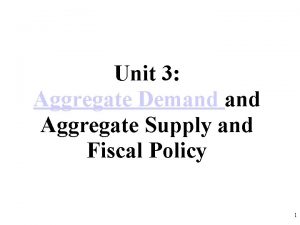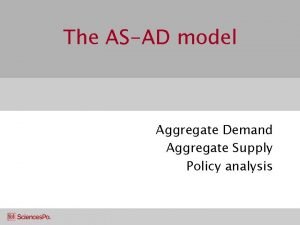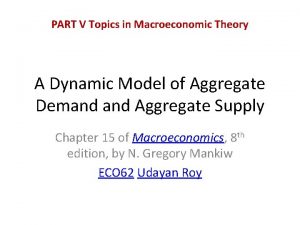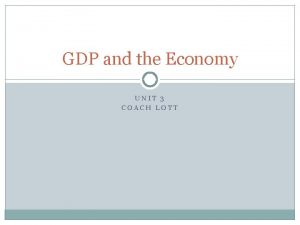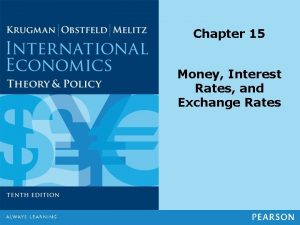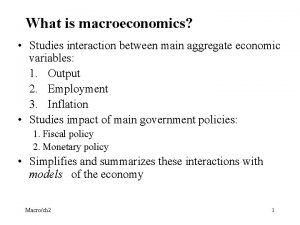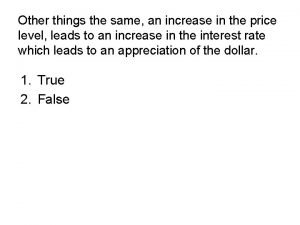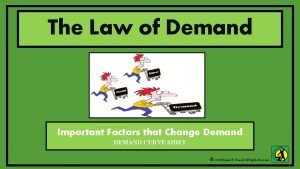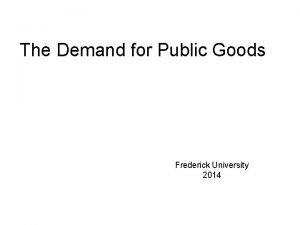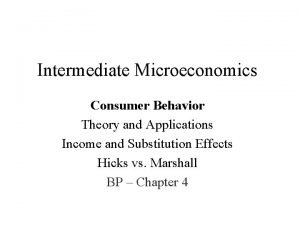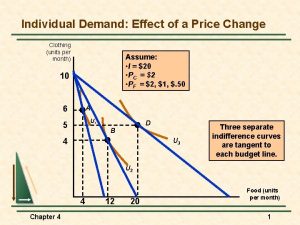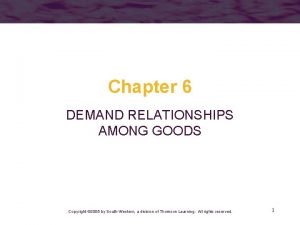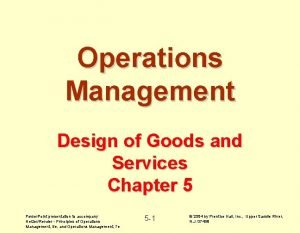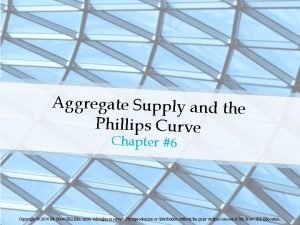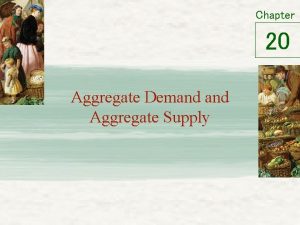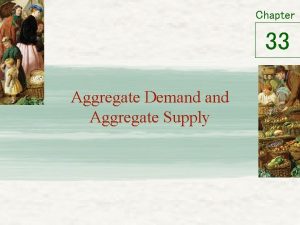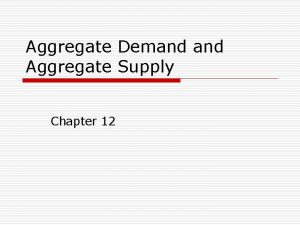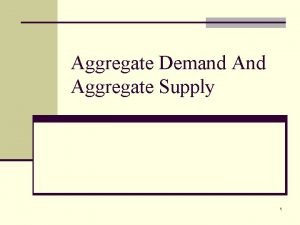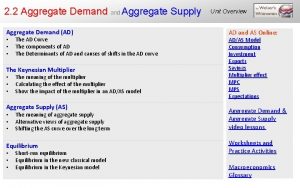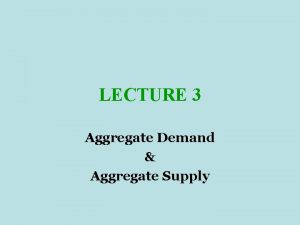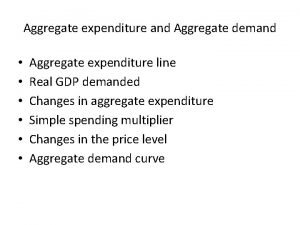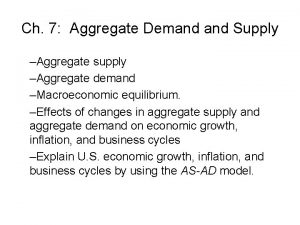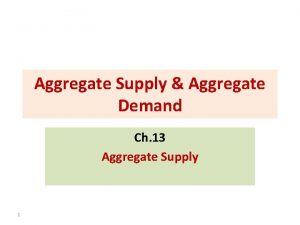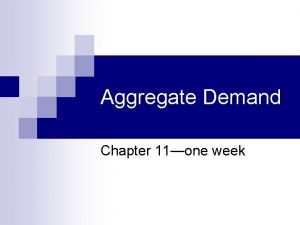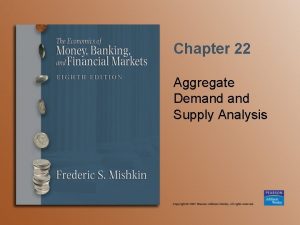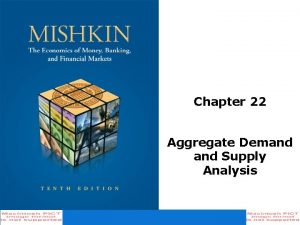CHAPTER 27 Aggregate Demand in the Goods and



























































- Slides: 59

CHAPTER 27 Aggregate Demand in the Goods and Money Markets Power. Point Lectures for Principles of Economics, 9 e ; ; By Karl E. Case, Ray C. Fair & Sharon M. Oster © 2009 Pearson Education, Inc. Publishing as Prentice Hall Principles of Economics 9 e by Case, Fair and Oster 1 of 57

CHAPTER 27 Aggregate Demand in the Goods and Money Markets © 2009 Pearson Education, Inc. Publishing as Prentice Hall Principles of Economics 9 e by Case, Fair and Oster 2 of 57

PART V THE CORE OF MACROECONOMIC THEORY 27 Aggregate Demand in the Goods and Money Markets Prepared by: Fernando & Yvonn Quijano © 2009 Pearson Education, Inc. Publishing as Prentice Hall Principles of Economics 9 e by Case, Fair and Oster

CHAPTER 27 Aggregate Demand in the Goods and Money Markets PART V THE CORE OF MACROECONOMIC THEORY Aggregate Demand in the Goods and Money Markets 27 CHAPTER OUTLINE Planned Investment and the Interest Rate Other Determinants of Planned Investment Planned Aggregate Expenditure and the Interest Rate Equilibrium in Both the Goods and Money Markets Policy Effects in the Goods and Money Markets Expansionary Policy Effects Contractionary Policy Effects The Macroeconomic Policy Mix The Aggregate Demand (AD) Curve The Aggregate Demand Curve: A Warning Other Reasons for a Downward-Sloping Aggregate Demand Curve Aggregate Expenditure and Aggregate Demand Shifts of the Aggregate Demand Curve Looking Ahead: Determining the Price Level Appendix: The IS-LM Diagram © 2009 Pearson Education, Inc. Publishing as Prentice Hall Principles of Economics 9 e by Case, Fair and Oster 4 of 57

CHAPTER 27 Aggregate Demand in the Goods and Money Markets goods market The market in which goods and services are exchanged and in which the equilibrium level of aggregate output is determined. money market The market in which financial instruments are exchanged and in which the equilibrium level of the interest rate is determined. © 2009 Pearson Education, Inc. Publishing as Prentice Hall Principles of Economics 9 e by Case, Fair and Oster 5 of 57

CHAPTER 27 Aggregate Demand in the Goods and Money Markets Planned Investment and the Interest Rate FIGURE 27. 1 Planned Investment Schedule Planned investment spending is a negative function of the interest rate. An increase in the interest rate from 3 percent to 6 percent reduces planned investment from I 0 to I 1. © 2009 Pearson Education, Inc. Publishing as Prentice Hall Principles of Economics 9 e by Case, Fair and Oster 6 of 57

CHAPTER 27 Aggregate Demand in the Goods and Money Markets Reducing the interest rate, ceteris paribus, is likely to: a. Increase the level of planned investment spending. b. Decrease the level of planned investment. c. Shift the demand for money curve to the right. d. Shift the supply of money curve to the right. © 2009 Pearson Education, Inc. Publishing as Prentice Hall Principles of Economics 9 e by Case, Fair and Oster 7 of 57

CHAPTER 27 Aggregate Demand in the Goods and Money Markets Reducing the interest rate, ceteris paribus, is likely to: a. Increase the level of planned investment spending. b. Decrease the level of planned investment. c. Shift the demand for money curve to the right. d. Shift the supply of money curve to the right. © 2009 Pearson Education, Inc. Publishing as Prentice Hall Principles of Economics 9 e by Case, Fair and Oster 8 of 57

Planned Investment and the Interest Rate CHAPTER 27 Aggregate Demand in the Goods and Money Markets Other Determinants of Planned Investment The assumption that planned investment depends only on the interest rate is obviously a simplification, just as is the assumption that consumption depends only on income. In practice, the decision of a firm on how much to invest depends on, among other things, its expectation of future sales. The optimism or pessimism of entrepreneurs about the future course of the economy can have an important effect on current planned investment. Keynes used the phrase animal spirits to describe the feelings of entrepreneurs, and he argued that these feelings affect investment decisions. © 2009 Pearson Education, Inc. Publishing as Prentice Hall Principles of Economics 9 e by Case, Fair and Oster 9 of 57

Planned Investment and the Interest Rate CHAPTER 27 Aggregate Demand in the Goods and Money Markets Other Determinants of Planned Investment Interest Rates and Investment Spending A recent study by Simon Gilchrist, Fabio Natalucci, and Egon Zakrajsek finds that interest rates have a powerful effect on the behavior of firms. © 2009 Pearson Education, Inc. Publishing as Prentice Hall Principles of Economics 9 e by Case, Fair and Oster 10 of

Planned Investment and the Interest Rate CHAPTER 27 Aggregate Demand in the Goods and Money Markets Planned Aggregate Expenditure and the Interest Rate We can use the fact that planned investment depends on the interest rate to consider how planned aggregate expenditure (AE) depends on the interest rate. Recall that planned aggregate expenditure is the sum of consumption, planned investment, and government purchases. AE ≡ C + I + G © 2009 Pearson Education, Inc. Publishing as Prentice Hall Principles of Economics 9 e by Case, Fair and Oster 11 of

Planned Investment and the Interest Rate CHAPTER 27 Aggregate Demand in the Goods and Money Markets Planned Aggregate Expenditure and the Interest Rate FIGURE 27. 2 The Effect of an Interest Rate Increase on Planned Aggregate Expenditure An increase in the interest rate from 3 percent to 6 percent lowers planned aggregate expenditure and thus reduces equilibrium income from Y 0 to Y 1. © 2009 Pearson Education, Inc. Publishing as Prentice Hall Principles of Economics 9 e by Case, Fair and Oster 12 of

Planned Investment and the Interest Rate CHAPTER 27 Aggregate Demand in the Goods and Money Markets Planned Aggregate Expenditure and the Interest Rate The effects of a change in the interest rate include: § A high interest rate (r) discourages planned investment (I). § Planned investment is a part of planned aggregate expenditure (AE). § Thus, when the interest rate rises, planned aggregate expenditure (AE) at every level of income falls. § Finally, a decrease in planned aggregate expenditure lowers equilibrium output (income) (Y) by a multiple of the initial decrease in planned investment. © 2009 Pearson Education, Inc. Publishing as Prentice Hall Principles of Economics 9 e by Case, Fair and Oster 13 of

CHAPTER 27 Aggregate Demand in the Goods and Money Markets Fill in the blanks. A higher interest rate _____ planned investment and causes planned aggregate expenditure to shift ______. a. increases; upward b. increases; downward c. decreases; upward d. decreases; downward © 2009 Pearson Education, Inc. Publishing as Prentice Hall Principles of Economics 9 e by Case, Fair and Oster 14 of

CHAPTER 27 Aggregate Demand in the Goods and Money Markets Fill in the blanks. A higher interest rate _____ planned investment and causes planned aggregate expenditure to shift ______. a. increases; upward b. increases; downward c. decreases; upward d. decreases; downward © 2009 Pearson Education, Inc. Publishing as Prentice Hall Principles of Economics 9 e by Case, Fair and Oster 15 of

Planned Investment and the Interest Rate CHAPTER 27 Aggregate Demand in the Goods and Money Markets Planned Aggregate Expenditure and the Interest Rate Using a convenient shorthand: © 2009 Pearson Education, Inc. Publishing as Prentice Hall Principles of Economics 9 e by Case, Fair and Oster 16 of

CHAPTER 27 Aggregate Demand in the Goods and Money Markets Equilibrium in Both the Goods and Money Markets An increase in the interest rate (r) decreases output (Y) in the goods market because an increase in r lowers planned investment. When income (Y) increase, this shifts the money demand curve to the right, which increases the interest rate (r) with a fixed money supply. We can thus write: © 2009 Pearson Education, Inc. Publishing as Prentice Hall Principles of Economics 9 e by Case, Fair and Oster 17 of

CHAPTER 27 Aggregate Demand in the Goods and Money Markets Which of the following statements describes the relationship between the goods market and the money market? a. An increase in money demand. b. An increase in money supply. c. A decrease in the interest rate. d. An increase in both the supply and the demand for money. © 2009 Pearson Education, Inc. Publishing as Prentice Hall Principles of Economics 9 e by Case, Fair and Oster 18 of

CHAPTER 27 Aggregate Demand in the Goods and Money Markets Which of the following statements describes the relationship between the goods market and the money market? a. An increase in money demand. b. An increase in money supply. c. A decrease in the interest rate. d. An increase in both the supply and the demand for money. © 2009 Pearson Education, Inc. Publishing as Prentice Hall Principles of Economics 9 e by Case, Fair and Oster 19 of

CHAPTER 27 Aggregate Demand in the Goods and Money Markets Equilibrium in Both the Goods and Money Markets FIGURE 27. 3 Links Between the Goods Market and the Money Market Planned investment depends on the interest rate, and money demand depends on aggregate output. © 2009 Pearson Education, Inc. Publishing as Prentice Hall Principles of Economics 9 e by Case, Fair and Oster 20 of

CHAPTER 27 Aggregate Demand in the Goods and Money Markets Which of the following is a link between the goods market and the money market? a. Income has considerable influence on the demand for money in the money market. b. The interest rate has significant effects on planned investment in the goods market. c. Both a and b above. d. None of the above. The goods market and the money market are not linked in the ways described above. © 2009 Pearson Education, Inc. Publishing as Prentice Hall Principles of Economics 9 e by Case, Fair and Oster 21 of

CHAPTER 27 Aggregate Demand in the Goods and Money Markets Which of the following is a link between the goods market and the money market? a. Income has considerable influence on the demand for money in the money market. b. The interest rate has significant effects on planned investment in the goods market. c. Both a and b above. d. None of the above. The goods market and the money market are not linked in the ways described above. © 2009 Pearson Education, Inc. Publishing as Prentice Hall Principles of Economics 9 e by Case, Fair and Oster 22 of

Policy Effects in the Goods and Money Markets CHAPTER 27 Aggregate Demand in the Goods and Money Markets Expansionary Policy Effects expansionary fiscal policy An increase in government spending or a reduction in net taxes aimed at increasing aggregate output (income) (Y). expansionary monetary policy An increase in the money supply aimed at increasing aggregate output (income) (Y). © 2009 Pearson Education, Inc. Publishing as Prentice Hall Principles of Economics 9 e by Case, Fair and Oster 23 of

CHAPTER 27 Aggregate Demand in the Goods and Money Markets Which of the following policy changes would be considered expansionary monetary policy? a. An increase in the money supply. b. An increase in net taxes. c. An increase in government spending. d. An increase in government borrowing. © 2009 Pearson Education, Inc. Publishing as Prentice Hall Principles of Economics 9 e by Case, Fair and Oster 24 of

CHAPTER 27 Aggregate Demand in the Goods and Money Markets Which of the following policy changes would be considered expansionary monetary policy? a. An increase in the money supply. b. An increase in net taxes. c. An increase in government spending. d. An increase in government borrowing. © 2009 Pearson Education, Inc. Publishing as Prentice Hall Principles of Economics 9 e by Case, Fair and Oster 25 of

Policy Effects in the Goods and Money Markets CHAPTER 27 Aggregate Demand in the Goods and Money Markets Expansionary Policy Effects Expansionary Fiscal Policy: An Increase in Government Purchases (G) or a Decrease in Net Taxes (T) crowding-out effect The tendency for increases in government spending to cause reductions in private investment spending. © 2009 Pearson Education, Inc. Publishing as Prentice Hall Principles of Economics 9 e by Case, Fair and Oster 26 of

Policy Effects in the Goods and Money Markets CHAPTER 27 Aggregate Demand in the Goods and Money Markets Expansionary Policy Effects Expansionary Fiscal Policy: An Increase in Government Purchases (G) or a Decrease in Net Taxes (T) FIGURE 27. 4 The Crowding-Out Effect An increase in government spending G from G 0 to G 1 shifts the planned aggregate expenditure schedule from 1 to 2. The crowding-out effect of the decrease in planned investment (brought about by the increased interest rate) then shifts the planned aggregate expenditure schedule from 2 to 3. © 2009 Pearson Education, Inc. Publishing as Prentice Hall Principles of Economics 9 e by Case, Fair and Oster 27 of

CHAPTER 27 Aggregate Demand in the Goods and Money Markets An increase in government spending (G), a. Increases planned aggregate expenditure, increases aggregate output, but may also cause a decrease in planned investment, which reduces both planned aggregate expenditure and aggregate output. b. Increases planned aggregate expenditure, increases aggregate output, and spurs even more planned investment, which further increases aggregate output. c. Decreases aggregate expenditure, planned investment, and aggregate output. d. All of the cases above have equal chance of occurring. © 2009 Pearson Education, Inc. Publishing as Prentice Hall Principles of Economics 9 e by Case, Fair and Oster 28 of

CHAPTER 27 Aggregate Demand in the Goods and Money Markets An increase in government spending (G), a. Increases planned aggregate expenditure, increases aggregate output, but may also cause a decrease in planned investment, which reduces both planned aggregate expenditure and aggregate output. b. Increases planned aggregate expenditure, increases aggregate output, and spurs even more planned investment, which further increases aggregate output. c. Decreases aggregate expenditure, planned investment, and aggregate output. d. All of the cases above have equal chance of occurring. © 2009 Pearson Education, Inc. Publishing as Prentice Hall Principles of Economics 9 e by Case, Fair and Oster 29 of

Policy Effects in the Goods and Money Markets CHAPTER 27 Aggregate Demand in the Goods and Money Markets Expansionary Policy Effects Expansionary Fiscal Policy: An Increase in Government Purchases (G) or a Decrease in Net Taxes (T) interest sensitivity or insensitivity of planned investment The responsiveness of planned investment spending to changes in the interest rate. Interest sensitivity means that planned investment spending changes a great deal in response to changes in the interest rate; interest insensitivity means little or no change in planned investment as a result of changes in the interest rate. Effects of an expansionary fiscal policy: © 2009 Pearson Education, Inc. Publishing as Prentice Hall Principles of Economics 9 e by Case, Fair and Oster 30 of

Policy Effects in the Goods and Money Markets CHAPTER 27 Aggregate Demand in the Goods and Money Markets Expansionary Policy Effects Expansionary Monetary Policy: An Increase in the Money Supply Effects of an expansionary monetary policy: © 2009 Pearson Education, Inc. Publishing as Prentice Hall Principles of Economics 9 e by Case, Fair and Oster 31 of

Policy Effects in the Goods and Money Markets CHAPTER 27 Aggregate Demand in the Goods and Money Markets Contractionary Policy Effects Contractionary Fiscal Policy: A Decrease in Government Spending (G) or an Increase in Net Taxes (T) contractionary fiscal policy A decrease in government spending or an increase in net taxes aimed at decreasing aggregate output (income) (Y). Effects of a contractionary fiscal policy: © 2009 Pearson Education, Inc. Publishing as Prentice Hall Principles of Economics 9 e by Case, Fair and Oster 32 of

Policy Effects in the Goods and Money Markets CHAPTER 27 Aggregate Demand in the Goods and Money Markets Contractionary Policy Effects Contractionary Monetary Policy: A Decrease in the Money Supply contractionary monetary policy A decrease in the money supply aimed at decreasing aggregate output (income) (Y). Effects of a contractionary monetary policy: © 2009 Pearson Education, Inc. Publishing as Prentice Hall Principles of Economics 9 e by Case, Fair and Oster 33 of

Policy Effects in the Goods and Money Markets CHAPTER 27 Aggregate Demand in the Goods and Money Markets The Macroeconomic Policy Mix policy mix The combination of monetary and fiscal policies in use at a given time. TABLE 27. 1 The Effects of the Macroeconomic Policy Mix Fiscal Policy Monetary Policy © 2009 Pearson Education, Inc. Publishing as Prentice Hall Principles of Economics 9 e by Case, Fair and Oster 34 of

CHAPTER 27 Aggregate Demand in the Goods and Money Markets Which policy mix favors investment spending over government spending? a. Expansionary fiscal policy and contractionary monetary policy. b. An increase in the money supply and a fall in government purchases. c. Both expansionary fiscal policy and expansionary monetary policy. d. None of the above. No policy mix favors investment over government spending. © 2009 Pearson Education, Inc. Publishing as Prentice Hall Principles of Economics 9 e by Case, Fair and Oster 35 of

CHAPTER 27 Aggregate Demand in the Goods and Money Markets Which policy mix favors investment spending over government spending? a. Expansionary fiscal policy and contractionary monetary policy. b. An increase in the money supply and a fall in government purchases. c. Both expansionary fiscal policy and expansionary monetary policy. d. None of the above. No policy mix favors investment over government spending. © 2009 Pearson Education, Inc. Publishing as Prentice Hall Principles of Economics 9 e by Case, Fair and Oster 36 of

CHAPTER 27 Aggregate Demand in the Goods and Money Markets The Aggregate Demand (AD) Curve aggregate demand The total demand for goods and services in the economy. aggregate demand (AD) curve A curve that shows the negative relationship between aggregate output (income) and the price level. Each point on the AD curve is a point at which both the goods market and the money market are in equilibrium. © 2009 Pearson Education, Inc. Publishing as Prentice Hall Principles of Economics 9 e by Case, Fair and Oster 37 of

CHAPTER 27 Aggregate Demand in the Goods and Money Markets The Aggregate Demand (AD) Curve FIGURE 27. 5 The Impact of an Increase in the Price Level on the Economy—Assuming No Changes in G, T, and Ms This figure shows that when P increases, Y decreases. © 2009 Pearson Education, Inc. Publishing as Prentice Hall Principles of Economics 9 e by Case, Fair and Oster 38 of

CHAPTER 27 Aggregate Demand in the Goods and Money Markets The Aggregate Demand (AD) Curve FIGURE 27. 6 The Aggregate Demand (AD) Curve At all points along the AD curve, both the goods market and the money market are in equilibrium. The policy variables G, T, and Ms are fixed. © 2009 Pearson Education, Inc. Publishing as Prentice Hall Principles of Economics 9 e by Case, Fair and Oster 39 of

CHAPTER 27 Aggregate Demand in the Goods and Money Markets Let P equal the aggregate price level. Assuming that G, T, and MS remain the same, the impact of an increase in the price level on the economy can be described as follows: a. b. c. d. e. © 2009 Pearson Education, Inc. Publishing as Prentice Hall Principles of Economics 9 e by Case, Fair and Oster 40 of

CHAPTER 27 Aggregate Demand in the Goods and Money Markets Let P equal the aggregate price level. Assuming that G, T, and MS remain the same, the impact of an increase in the price level on the economy can be described as follows: a. b. c. d. e. © 2009 Pearson Education, Inc. Publishing as Prentice Hall Principles of Economics 9 e by Case, Fair and Oster 41 of

The Aggregate Demand (AD) Curve CHAPTER 27 Aggregate Demand in the Goods and Money Markets The Aggregate Demand Curve: A Warning It is important that you realize what the aggregate demand curve represents. The aggregate demand curve is more complex than a simple individual or market demand curve. The AD curve is not a market demand curve, and it is not the sum of all market demand curves in the economy. To understand what the aggregate demand curve represents, you must understand the interaction between the goods market and the money markets. © 2009 Pearson Education, Inc. Publishing as Prentice Hall Principles of Economics 9 e by Case, Fair and Oster 42 of

The Aggregate Demand (AD) Curve CHAPTER 27 Aggregate Demand in the Goods and Money Markets Other Reasons for a Downward-Sloping Aggregate Demand Curve The Consumption Link The consumption link provides another reason for the AD curve’s downward slope. An increase in the price level increases the demand for money, which leads to an increase in the interest rate, which leads to a decrease in consumption (as well as planned investment), which leads to a decrease in aggregate output (income). © 2009 Pearson Education, Inc. Publishing as Prentice Hall Principles of Economics 9 e by Case, Fair and Oster 43 of

The Aggregate Demand (AD) Curve CHAPTER 27 Aggregate Demand in the Goods and Money Markets Other Reasons for a Downward-Sloping Aggregate Demand Curve The Consumption Link The initial decrease in consumption (brought about by the increase in the interest rate) contributes to the overall decrease in output. Planned investment does not bear all the burden of providing the link from a higher interest rate to a lower level of aggregate output. Decreased consumption brought about by a higher interest rate also contributes to this effect. © 2009 Pearson Education, Inc. Publishing as Prentice Hall Principles of Economics 9 e by Case, Fair and Oster 44 of

The Aggregate Demand (AD) Curve CHAPTER 27 Aggregate Demand in the Goods and Money Markets Other Reasons for a Downward-Sloping Aggregate Demand Curve The Real Wealth Effect real wealth, or real balance, effect The change in consumption brought about by a change in real wealth that results from a change in the price level. © 2009 Pearson Education, Inc. Publishing as Prentice Hall Principles of Economics 9 e by Case, Fair and Oster 45 of

The Aggregate Demand (AD) Curve CHAPTER 27 Aggregate Demand in the Goods and Money Markets Aggregate Expenditure and Aggregate Demand At equilibrium, planned aggregate expenditure (AE ≡ C + I + G) and aggregate output (Y) are equal: equilibrium condition: C + I + G = Y © 2009 Pearson Education, Inc. Publishing as Prentice Hall Principles of Economics 9 e by Case, Fair and Oster 46 of

CHAPTER 27 Aggregate Demand in the Goods and Money Markets Along the aggregate demand curve, each point represents: a. Equilibrium in the goods market, regardless of the equilibrium situation in the money market. b. Equilibrium in the money market, regardless of the equilibrium situation in the goods market. c. Simultaneous equilibrium in both the goods and money markets. d. Macroeconomic equilibrium, or equilibrium in all markets of the economy. © 2009 Pearson Education, Inc. Publishing as Prentice Hall Principles of Economics 9 e by Case, Fair and Oster 47 of

CHAPTER 27 Aggregate Demand in the Goods and Money Markets Along the aggregate demand curve, each point represents: a. Equilibrium in the goods market, regardless of the equilibrium situation in the money market. b. Equilibrium in the money market, regardless of the equilibrium situation in the goods market. c. Simultaneous equilibrium in both the goods and money markets. d. Macroeconomic equilibrium, or equilibrium in all markets of the economy. © 2009 Pearson Education, Inc. Publishing as Prentice Hall Principles of Economics 9 e by Case, Fair and Oster 48 of

The Aggregate Demand (AD) Curve CHAPTER 27 Aggregate Demand in the Goods and Money Markets Shifts of the Aggregate Demand Curve FIGURE 27. 7 The Effect of an Increase in Money Supply on the AD Curve An increase in the money supply (Ms) causes the aggregate demand curve to shift to the right, from AD 0 to AD 1. This shift occurs because the increase in Ms lowers the interest rate, which increases planned investment (and thus planned aggregate expenditure). The final result is an increase in output at each possible price level. © 2009 Pearson Education, Inc. Publishing as Prentice Hall Principles of Economics 9 e by Case, Fair and Oster 49 of

The Aggregate Demand (AD) Curve CHAPTER 27 Aggregate Demand in the Goods and Money Markets Shifts of the Aggregate Demand Curve FIGURE 27. 8 The Effect of an Increase in Government Purchases or a Decrease in Net Taxes on the AD Curve An increase in government purchases (G) or a decrease in net taxes (T) causes the aggregate demand curve to shift to the right, from AD 0 to AD 1. The increase in G increases planned aggregate expenditure, which leads to an increase in output at each possible price level. A decrease in T causes consumption to rise. The higher consumption then increases planned aggregate expenditure, which leads to an increase in output at each possible price level. © 2009 Pearson Education, Inc. Publishing as Prentice Hall Principles of Economics 9 e by Case, Fair and Oster 50 of

The Aggregate Demand (AD) Curve CHAPTER 27 Aggregate Demand in the Goods and Money Markets Shifts of the Aggregate Demand Curve FIGURE 27. 9 Factors That Shift the Aggregate Demand Curve © 2009 Pearson Education, Inc. Publishing as Prentice Hall Principles of Economics 9 e by Case, Fair and Oster 51 of

CHAPTER 27 Aggregate Demand in the Goods and Money Markets Which of the following policy mixes consistently shifts the aggregate demand curve to the right? a. Expansionary monetary policy accompanied by contractionary fiscal policy. b. Contractionary monetary policy accompanied by contractionary fiscal policy. c. Contractionary monetary policy accompanied by expansionary fiscal policy. d. Expansionary monetary policy accompanied by expansionary fiscal policy. © 2009 Pearson Education, Inc. Publishing as Prentice Hall Principles of Economics 9 e by Case, Fair and Oster 52 of

CHAPTER 27 Aggregate Demand in the Goods and Money Markets Which of the following policy mixes consistently shifts the aggregate demand curve to the right? a. Expansionary monetary policy accompanied by contractionary fiscal policy. b. Contractionary monetary policy accompanied by contractionary fiscal policy. c. Contractionary monetary policy accompanied by expansionary fiscal policy. d. Expansionary monetary policy accompanied by expansionary fiscal policy. © 2009 Pearson Education, Inc. Publishing as Prentice Hall Principles of Economics 9 e by Case, Fair and Oster 53 of

CHAPTER 27 Aggregate Demand in the Goods and Money Markets REVIEW TERMS AND CONCEPTS aggregate demand (AD) curve contractionary fiscal policy contractionary monetary policy crowding-out effect expansionary fiscal policy expansionary monetary policy goods market interest sensitivity or insensitivity of planned investment money market policy mix real wealth, or real balance, effect © 2009 Pearson Education, Inc. Publishing as Prentice Hall Principles of Economics 9 e by Case, Fair and Oster 54 of

APPENDIX A THE IS-LM DIAGRAM CHAPTER 27 Aggregate Demand in the Goods and Money Markets THE IS CURVE An IS curve illustrates the negative relationship between the equilibrium value of aggregate output (income) (Y) and the interest rate in the goods market. FIGURE 27 A. 1 The IS Curve Each point on the IS curve corresponds to the equilibrium point in the goods market for the given interest rate. When government spending (G) increases, the IS curve shifts to the right, from IS 0 to IS 1. © 2009 Pearson Education, Inc. Publishing as Prentice Hall Principles of Economics 9 e by Case, Fair and Oster 55 of

APPENDIX A THE IS-LM DIAGRAM CHAPTER 27 Aggregate Demand in the Goods and Money Markets THE LM CURVE An LM curve illustrates the positive relationship between the equilibrium value of the interest rate and aggregate output (income) (Y) in the money market. FIGURE 27 A. 2 The LM Curve Each point on the LM curve corresponds to the equilibrium point in the money market for the given value of aggregate output (income). Money supply (Ms) increases shift the LM curve to the right, from LM 0 to LM 1. © 2009 Pearson Education, Inc. Publishing as Prentice Hall Principles of Economics 9 e by Case, Fair and Oster 56 of

APPENDIX A THE IS-LM DIAGRAM CHAPTER 27 Aggregate Demand in the Goods and Money Markets THE IS-LM DIAGRAM The IS-LM diagram is a way of depicting graphically the determination of aggregate output (income) and the interest rate in the goods and money markets. FIGURE 27 A. 3 The IS-LM Diagram The point at which the IS and LM curves intersect corresponds to the point at which both the goods market and the money market are in equilibrium. The equilibrium values of aggregate output and the interest rate are Y 0 and r 0. © 2009 Pearson Education, Inc. Publishing as Prentice Hall Principles of Economics 9 e by Case, Fair and Oster 57 of

APPENDIX A THE IS-LM DIAGRAM CHAPTER 27 Aggregate Demand in the Goods and Money Markets THE IS-LM DIAGRAM FIGURE 27 A. 4 An Increase in Government Purchases (G) When G increases, the IS curve shifts to the right. This increases the equilibrium value of both Y and r. © 2009 Pearson Education, Inc. Publishing as Prentice Hall Principles of Economics 9 e by Case, Fair and Oster 58 of

APPENDIX A THE IS-LM DIAGRAM CHAPTER 27 Aggregate Demand in the Goods and Money Markets THE IS-LM DIAGRAM FIGURE 27 A. 5 An Increase in the Money Supply (Ms) When Ms increases, the LM curve shifts to the right. This increases the equilibrium value of Y and decreases the equilibrium value of r. © 2009 Pearson Education, Inc. Publishing as Prentice Hall Principles of Economics 9 e by Case, Fair and Oster 59 of
 Chapter 33 aggregate demand and aggregate supply
Chapter 33 aggregate demand and aggregate supply Ad curve graph
Ad curve graph Unit 3 aggregate demand aggregate supply and fiscal policy
Unit 3 aggregate demand aggregate supply and fiscal policy Tax multiplier formula
Tax multiplier formula Unit 3 aggregate demand aggregate supply and fiscal policy
Unit 3 aggregate demand aggregate supply and fiscal policy Consumer product classifications include
Consumer product classifications include Cannot mix aggregate and non aggregate tableau
Cannot mix aggregate and non aggregate tableau Aggregate supply shifters
Aggregate supply shifters Aggregate demand supply graph
Aggregate demand supply graph Disaggregate planning
Disaggregate planning Progressive tax definition
Progressive tax definition Merit goods vs public goods
Merit goods vs public goods Publik goods
Publik goods Shifters of aggregate supply rap
Shifters of aggregate supply rap How to calculate aggregate demand
How to calculate aggregate demand Dad-das model
Dad-das model Aggregate demand curve
Aggregate demand curve Recessionary gap aggregate demand
Recessionary gap aggregate demand Long run aggregate supply curve
Long run aggregate supply curve The aggregate real money demand schedule l(r,y)
The aggregate real money demand schedule l(r,y) The aggregate real money demand schedule l(r,y)
The aggregate real money demand schedule l(r,y) What is expansionary monetary policy
What is expansionary monetary policy Nominal gdp and real gdp example
Nominal gdp and real gdp example Aggregate demand graph
Aggregate demand graph Which of the following shifts aggregate demand to the left?
Which of the following shifts aggregate demand to the left? Module 5 supply and demand introduction and demand
Module 5 supply and demand introduction and demand Demand for complementary goods
Demand for complementary goods Public goods demand curve
Public goods demand curve Demand curve for giffen goods
Demand curve for giffen goods Individual demand for fashion goods is affected by
Individual demand for fashion goods is affected by Demand relationships among goods
Demand relationships among goods Fiscal measures to correct deficient demand
Fiscal measures to correct deficient demand Dependent demand inventory means
Dependent demand inventory means Ano ang demand schedule?
Ano ang demand schedule? Demand forecasting methods in managerial economics
Demand forecasting methods in managerial economics Distinguish between individual demand and market demand
Distinguish between individual demand and market demand Dependent demand items
Dependent demand items Deterministic and stochastic inventory models
Deterministic and stochastic inventory models Market demand curve
Market demand curve Independent demand dan dependent demand
Independent demand dan dependent demand Design of goods and services in operations management
Design of goods and services in operations management Chapter 8 inventories and the cost of goods sold
Chapter 8 inventories and the cost of goods sold Aggregate of chapter 6
Aggregate of chapter 6 Hát kết hợp bộ gõ cơ thể
Hát kết hợp bộ gõ cơ thể Frameset trong html5
Frameset trong html5 Bổ thể
Bổ thể Tỉ lệ cơ thể trẻ em
Tỉ lệ cơ thể trẻ em Voi kéo gỗ như thế nào
Voi kéo gỗ như thế nào Glasgow thang điểm
Glasgow thang điểm Bài hát chúa yêu trần thế alleluia
Bài hát chúa yêu trần thế alleluia Các môn thể thao bắt đầu bằng tiếng nhảy
Các môn thể thao bắt đầu bằng tiếng nhảy Thế nào là hệ số cao nhất
Thế nào là hệ số cao nhất Các châu lục và đại dương trên thế giới
Các châu lục và đại dương trên thế giới Công thức tiính động năng
Công thức tiính động năng Trời xanh đây là của chúng ta thể thơ
Trời xanh đây là của chúng ta thể thơ Mật thư tọa độ 5x5
Mật thư tọa độ 5x5 Phép trừ bù
Phép trừ bù độ dài liên kết
độ dài liên kết Các châu lục và đại dương trên thế giới
Các châu lục và đại dương trên thế giới Thể thơ truyền thống
Thể thơ truyền thống













